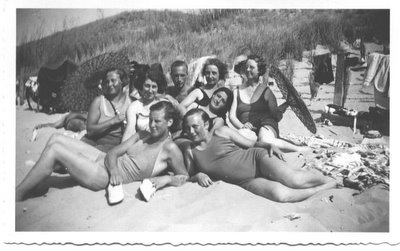
Este fin de semana estuve en Paris, junto con mi compañera de 38 años (de vivir juntos). Viajando hacia Paris en tren leí el libro de Joseph Roth,
La Cripta de los Capuchinos (1938), y volviendo a Amsterdam el domingo por la noche lo terminé. El libro de Roth me acompaño en este viaje como un testigo con quien tuve un diálogo constante, sin hablar, sólo susurrando, silencioso.
Mais aussi j'avais des discussions avec nos amis, él (36 años, Parisien) y ella (26 años, de Latvia, Israel) y él (82 años, czecho, viviendo en Paris después de muchos años de exilio en los EEUU y otros países). Y mientras tanto visitábamos una exhibición sobre melancolía y otra sobre la destrucción y la creación en el siglo XX... Y todo parecía decirnos lo mismo: en qué mundo estamos viviendo?
La historia del siglo XX está todavía muy presente, vivimos con ella, sin entender muy bien lo que estamos viviendo. En algunas cosas hemos avanzado y en otras atrasado. Seguimos destruyendo y creando y seguimos adaptándonos y callándonos.
Ésta mañana, durante el desayuno, dije a mi compañera: 'No logramos cuidar los diálogos con nuestros amigos... No logramos escribirles una carta larga y seguir la conversación...'
'Yo trato de hacerlo,' me dijo ella.
Pensaba incluir una foto de la exposición "Big bang: destruction et création dans l'art du 20-e siècle" à Centre Pompidou, pero abriendo mi archivo de fotos elegí ésta, tomada en 1958 (pienso), en la escuela primaria.
Sobre el escritor Joseph Roth (1894-1939) encontré en Internet lo siguiente, en inglés (en un website de Jon Hughes), pero como varios de los libros de Joseph Roth han sido traducidos en castellano...
Joseph Roth remains little known outside the German-speaking countries, despite being amongst the most prolific and talented writers of the twentieth century. He is best remembered for two novels recreating, respectively, the shtetl of the Eastern Jews (Hiob or Job, 1930), and the vanished world of the Habsburg monarchy (Radetzkymarsch or The Radetzky March, 1932). However, Roth was one of the best-known and highest paid journalists in the Weimar Republic, whose articles and Feuilletons about Berlin, Paris, Russia and other places seemed to capture the energy and ambivalence of the Zeitgeist, a culture dazzled by competing ideologies, new technologies, and a burgeoning entertainment industry. His novels from the 1920s, the most famous of which is Die Flucht ohne Ende (Flight without End, 1927), portray a damaged generation of young men and women as vividly as those of Hemingway or Fitzgerald.
Further, his life was in many ways an extraordinary one. Roth was born to German-speaking Jewish parents in fin-de-siècle Austria-Hungary, close to the border with Russia. Though he is often thought of as an archetypally 'Austrian' writer, his place of birth, Brody, was located many hundreds of miles away from Vienna. Today it is part of the Ukraine. Roth grew up in a diverse community, in which Jews and gentiles, German, Polish, Yiddish and Ukrainian speakers, and soldiers, farmers and tradespeople lived cheek by jowl. The sense of loss he felt with the disappearance of this community, which could not survive the collapse of empire, was to mark Roth profoundly. His work frequently revolves around the feeling of being literally and metaphorically homeless.
Roth, in his journalism and in his fiction, looked to greater values than the merely political or pragmatic. The parochialism of German and Austrian society, and their intolerance of difference, depressed him deeply. In his work he sought to celebrate and defend our common humanity, drawing on his provincial childhood, his Jewishness, the experience of war, revolution and social upheaval, and the restless, hotel-dwelling lifestyle of a cosmopolitan journalist.
Ultimately, as with so many of his co-religionists and fellow liberals, Roth was forced into exile, which he spent for the most part in Paris, a city he loved. His final years were characterised by financial troubles, acute alcoholism, and an increasingly eccentric political stance (despite the socialist attitude of his early years, he favoured the re-establishment of the Habsburg empire). Yet he continued to write until the last, and was a tireless and vocal opponent of Hitler's regimes and its supporters. His final work, Die Legende vom heiligen Trinker (The Legend of the Holy Drinker, 1939), is amongst his finest. The tale of an alcoholic seeking redemption by repaying a loan reflects both Roth's ambiguous spirituality, and his belief in the necessity of justice, of balancing the scales.
This website is entirely the work of Jon Hughes.


















